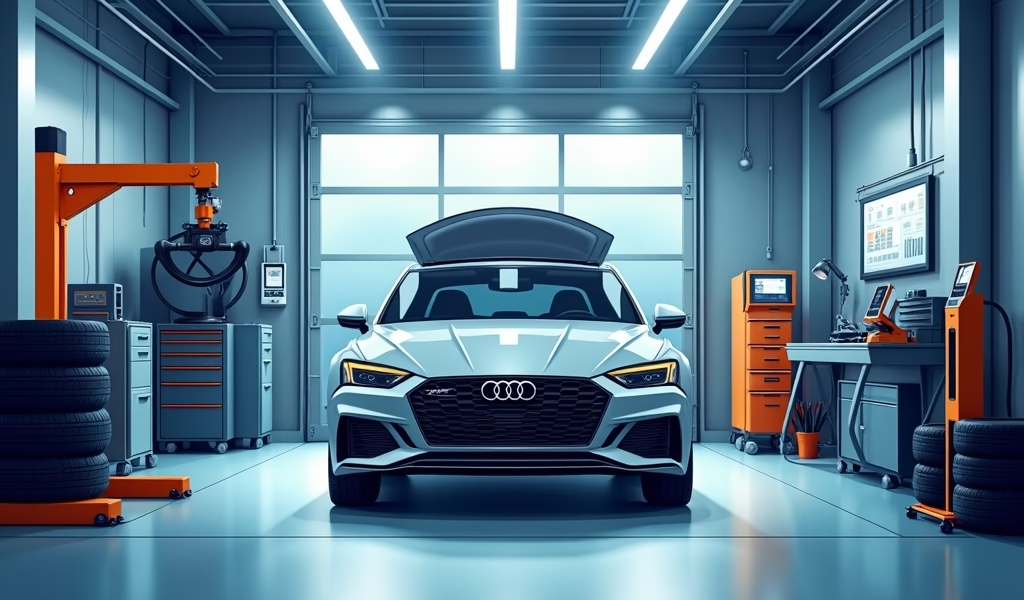Overview
This article provides seven essential car maintenance tips from a 25-year veteran mechanic, covering service schedules, fluid checks, tire care, battery maintenance, recognizing warning signs, knowing when to DIY versus seeking professional help, and finding a trusted mechanic. Regular preventive maintenance is presented as the key to extending vehicle life beyond 200,000 miles while avoiding costly repairs and breakdowns.
Table of Contents
- Understanding Car Maintenance: The Basics
- Tip 1: Follow Your Vehicle’s Service Schedule
- Tip 2: Perform Regular Fluid Checks
- Tip 3: Don’t Neglect Tire Maintenance
- Tip 4: Battery Care and Inspection
- Tip 5: Recognize Early Warning Signs
- Tip 6: Know When to DIY and When to Call a Pro
- Tip 7: Find a Trusted Mechanic
- Conclusion
- Frequently Asked Questions
Understanding Car Maintenance: The Basics
Let’s face it – your vehicle is probably one of the most expensive investments you’ll make, second only to your home. Yet many of us treat car repair and maintenance as an afterthought, something to deal with only when warning lights flash or strange noises emerge from under the hood.
After 25 years as a certified mechanic, I’ve seen firsthand how regular maintenance not only extends a vehicle’s life but saves serious money in the long run. Think of your car like your body – preventive care beats emergency surgery every time!
The truth is, modern vehicles are engineering marvels that can easily surpass 200,000 miles with proper care. I’ve watched well-maintained family sedans cruise comfortably past the quarter-million-mile mark while neglected luxury vehicles barely limp to 100,000.
The essential auto maintenance tips I’m sharing today aren’t just mechanic talk – they’re practical wisdom from decades in the garage that will help keep your trusty mechanical companion running smoothly for years to come. Let’s roll up our sleeves and dive in!
Tip 1: Follow Your Vehicle’s Service Schedule
That owner’s manual gathering dust in your glove compartment? It’s actually a gold mine of information specifically tailored to your vehicle. Car manufacturers have invested millions in research to determine exactly what maintenance your car needs and when it needs it.
Your manual outlines a maintenance schedule that’s not just a suggestion – it’s a carefully calculated roadmap for optimal vehicle performance. Skip these service intervals at your own risk (and expense).
What should you be tracking?
- Oil changes (typically every 3,000-7,500 miles depending on your vehicle)
- Air and cabin filter replacements
- Spark plug replacements
- Timing belt service (a big one that can cause catastrophic engine failure if neglected)
- Transmission fluid service
Pro tip: Create a simple calendar reminder system that alerts you a week before each service is due. If your vehicle has digital service reminders, learn how to use them – they’re there for a reason!
According to a AAA study on vehicle maintenance, cars that follow manufacturer-recommended service schedules last 60% longer than those that receive only emergency repairs. That’s not just a few extra months – we’re talking years of additional service from your vehicle.
Remember that timing matters too. Seasonal changes often require specific maintenance – particularly if you live somewhere with extreme weather. Winter car maintenance is especially crucial for preventing cold-weather breakdowns when you’re most vulnerable.

Tip 2: Perform Regular Fluid Checks
Your vehicle runs on a complex system of fluids that lubricate, cool, clean, and power various components. Think of these fluids as your car’s lifeblood – when they’re low or degraded, systems begin to fail.
I recommend a monthly “five-fluid check” routine that takes less than 10 minutes but can prevent thousands in repairs:
- Engine oil: The most critical fluid. Check when cool, parked on level ground. The color should be amber to light brown – dark, gritty oil needs changing. Low oil can cause catastrophic engine damage.
- Coolant: Never open a hot radiator! Check the transparent reservoir when cool. The level should be between the “min” and “max” lines, and the color should be bright (usually green, orange, or pink).
- Power steering fluid: Often overlooked until steering becomes difficult. Check with the engine warm and running.
- Brake fluid: Safety-critical! The reservoir is typically transparent and mounted near the firewall. Low fluid could indicate worn brake pads or a dangerous leak.
- Windshield washer fluid: Not critical for engine function but essential for safety. Keep it topped up year-round.
One thing I’ve noticed in my years at the shop: cars that come in with proper fluid levels typically have owners who catch other issues early too. It’s all about developing that maintenance mindset.
Beyond checking levels, pay attention to how often car maintenance intervals come up for fluid replacements. Fresh fluids perform better than old ones, even when levels are correct. Most fluids degrade over time through heat cycling and contamination.
Tip 3: Don’t Neglect Tire Maintenance
Your tires are literally where the rubber meets the road – the only points of contact between your two-ton vehicle and the asphalt. Proper tire maintenance isn’t just about avoiding flats; it impacts safety, handling, fuel economy, and overall driving comfort.
I’ve seen too many preventable accidents caused by neglected tires. Here’s my simple tire care routine:
- Monthly pressure checks: Use a quality gauge to check pressure when tires are cold. The correct pressure is listed on the driver’s door jamb sticker – not the tire sidewall (that’s the maximum, not the recommended).
- Tread depth inspection: Use the penny test – insert a penny with Lincoln’s head upside down into the tread. If you can see the top of his head, your tread is too worn.
- Rotation every 5,000-7,000 miles: This ensures even wear and extends tire life by up to 20%.
- Alignment check annually: If your vehicle pulls to one side or the steering wheel vibrates, don’t wait – get an alignment check immediately.
Uneven wear patterns tell a story about your vehicle’s condition. Excessive inner or outer edge wear often indicates alignment issues. Scalloped patterns might mean suspension problems. Center wear typically points to overinflation, while wear on both edges suggests underinflation.
The National Highway Traffic Safety Administration estimates that properly maintained tires can improve fuel efficiency by up to 3.3%. That might not sound like much, but it adds up to hundreds of dollars over the life of your tires.
Tip 4: Battery Care and Inspection
Nothing ruins your day quite like turning the key and hearing… nothing. Battery failures account for nearly half of all roadside service calls, yet basic battery maintenance can prevent most of these situations.
Even in our age of “maintenance-free” batteries, a little attention goes a long way:
- Visual inspection: Look for corrosion (white or greenish powder) on terminals. This creates resistance that can prevent starting.
- Clean connections: Remove corrosion using a wire brush and a solution of baking soda and water. Dry thoroughly and apply a thin coat of petroleum jelly to prevent future buildup.
- Check mounting: Ensure the battery is securely fastened. A loose battery can sustain internal damage from vibration.
- Test regularly: Most auto parts stores will test your battery for free. Consider seasonal testing, especially before winter when cold temperatures reduce battery capacity.
Modern vehicles are particularly sensitive to battery voltage. Even slightly low voltage can cause mysterious electrical gremlins – from flickering lights to erratic dashboard warnings and even transmission shifting problems.
I recommend replacing batteries preventively at the 4-year mark in hot climates and the 5-year mark in moderate climates. The small cost of a planned replacement beats the hassle and potential towing expense of an unexpected failure.

Tip 5: Recognize Early Warning Signs
Your vehicle communicates problems long before they become serious – if you know how to listen. After thousands of diagnostic sessions, I’ve learned that cars rarely fail without warning. The trick is understanding the signals.
Here’s what to watch (and listen) for:
- Unusual sounds: Each type of noise hints at specific issues. Grinding during braking? Worn pads. High-pitched squeal when starting? Likely a loose belt. Knocking or ticking from the engine? Could be serious internal issues.
- Warning lights: Don’t ignore that check engine light! Modern vehicles have sophisticated monitoring systems. A solid light indicates a problem needs attention soon; a flashing light means drive cautiously and get service immediately.
- Fluid spots: Check your parking spot for drips. Clear water is normal (AC condensation), but colored fluids need investigation. Red is transmission fluid, green/orange is coolant, brown/black is oil – all serious concerns.
- Performance changes: Hard starting, rough idling, hesitation during acceleration, or decreased fuel economy can all signal developing problems.
I can’t tell you how many times I’ve had customers say, “It just started making that noise yesterday,” when wear patterns clearly show the issue has been developing for months. Trust your senses – if something feels, sounds, or smells different, it probably is.
Early intervention often means the difference between a simple fix and a major repair. For example, replacing brake pads at the first squeal costs around $150-300, while waiting until you hear grinding can add rotors to the job, doubling the cost.
Tip 6: Know When to DIY and When to Call a Pro
I love seeing car owners take an interest in maintaining their vehicles. There’s something satisfying about completing your own repairs – but knowing your limits is just as important as knowing how to change your oil.
Here’s my honest guide to what most owners can handle and what’s best left to professionals:
DIY-Friendly Tasks:
- Wiper blade replacement: Simple, requires no tools, and takes minutes.
- Air filter changes: Usually requires just opening a few clips or removing a few screws.
- Bulb replacements: Varies by vehicle – some are simple, others require partial disassembly.
- Battery replacement: Straightforward but remember to disconnect negative terminal first!
- Oil changes: Doable with basic tools and a safe way to lift the vehicle.
Leave to the Pros:
- Anything involving airbags: Safety systems require specialized knowledge and tools.
- Timing belt/chain service: Precision timing is critical – errors can cause catastrophic engine damage.
- Transmission repairs: Complex systems with hundreds of parts requiring specific tools and expertise.
- Major brake work: Basic pad changes might be DIY-friendly, but anything involving hydraulics affects safety.
- Engine internal repairs: Requires specialized tools, torque specifications, and extensive knowledge.
The DIY approach works best when you have the right resources: a factory service manual (not just the owner’s manual), proper tools, and enough time to complete the job without rushing. YouTube tutorials can be helpful but verify the source knows what they’re talking about – I’ve seen some dangerously incorrect advice online.
Remember, even seasoned mechanics sometimes encounter unexpected complications. Always have a backup plan if your DIY project goes sideways.
Tip 7: Find a Trusted Mechanic
Finding a good mechanic isn’t just about who offers the lowest price – it’s about building a relationship with someone who understands your vehicle and your priorities. As someone who’s been on both sides of the service counter, I can tell you that mutual trust makes all the difference.
Here’s how to find and build a relationship with a quality shop:
- Look for certifications: ASE (Automotive Service Excellence) certification means technicians have passed standardized testing in their specialty areas.
- Ask for recommendations: Personal referrals are still the best way to find good service. Ask friends with similar vehicles about their experiences.
- Start small: Begin with minor services like oil changes to get a feel for a shop’s communication style, cleanliness, and professionalism.
- Expect explanations: Good mechanics explain what’s wrong, show you the problem parts when possible, and discuss your options without pressuring you.
- Consistent communication: A quality shop will call if they find additional problems, explain why they’re important, and get your authorization before proceeding.
Don’t be afraid to ask questions! In my experience, the best customers are engaged and curious. We’d much rather explain something clearly than have you leave with concerns or confusion.
Once you find a shop you trust, stick with them. Consistent service with one provider creates a maintenance history that helps identify patterns and predict potential issues. Many shops also offer loyalty benefits for regular customers.
Remember that the cheapest quote isn’t always the best value. I’ve repaired countless vehicles damaged by cut-rate work. Quality parts and proper procedures matter – the few dollars saved today might cost hundreds tomorrow.
Conclusion
Car repair and maintenance doesn’t have to be intimidating or expensive. With these seven proven tips, you’re well on your way to extending your vehicle’s life, improving its performance, and avoiding those dreaded roadside breakdowns.
Remember, your car is designed to provide hundreds of thousands of miles of reliable service – but only if you give it the care it needs. The few minutes you spend checking fluids, inspecting tires, or scheduling regular maintenance will pay dividends in reliability and reduced repair costs.
As someone who’s spent decades working on every type of vehicle imaginable, I can promise you that the difference between a car that lasts 100,000 miles and one that surpasses 250,000 isn’t luck – it’s consistent, thoughtful maintenance.
Take pride in caring for your vehicle. Listen to its warning signs, follow the recommended service schedule, find a trustworthy mechanic, and learn which tasks you can handle yourself. Your car will thank you with years of trouble-free service, and your wallet will appreciate the savings from avoided major repairs.
After all, in our busy lives, few things are more valuable than a vehicle that starts reliably every time and gets you safely where you need to go.
Frequently Asked Questions
How often should I really change my oil?
For conventional oil, every 3,000-5,000 miles is ideal, while synthetic oil can last 7,500-10,000 miles. Always follow your manufacturer’s recommendations as listed in your owner’s manual, not what the quick lube shop suggests.
What’s the most important maintenance item that people often skip?
Timing belt replacement is frequently overlooked yet critical—a failure can destroy your engine. This service typically comes due between 60,000-100,000 miles depending on your vehicle.
Can I safely ignore my check engine light if the car seems to be running fine?
No—the light means a system isn’t functioning correctly even if you don’t notice performance issues. Have it scanned promptly as minor issues can develop into major problems if left unchecked.
How can I tell if my mechanic is being honest about needed repairs?
Ask them to show you the worn or failed parts and explain why the repair is necessary. A trustworthy mechanic will educate rather than intimidate and shouldn’t pressure you into immediate decisions for non-safety issues.
What’s the single best thing I can do to extend my vehicle’s life?
Follow the manufacturer’s recommended maintenance schedule without exception. Regular fluid changes and inspections as outlined in your owner’s manual will prevent most major failures and significantly extend your vehicle’s service life.

